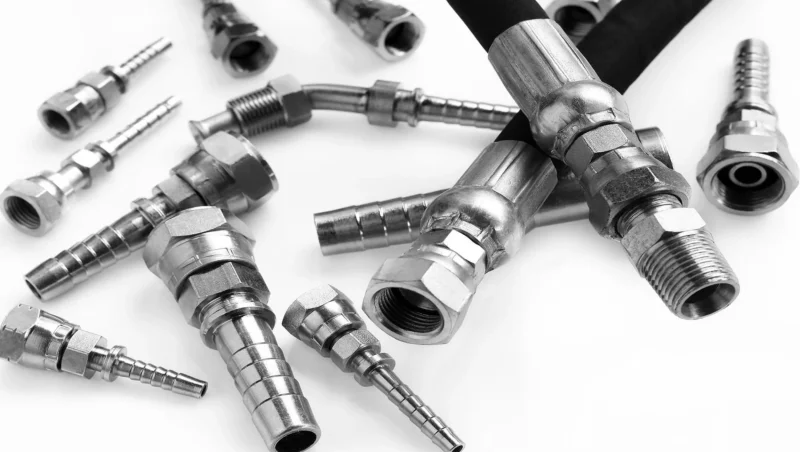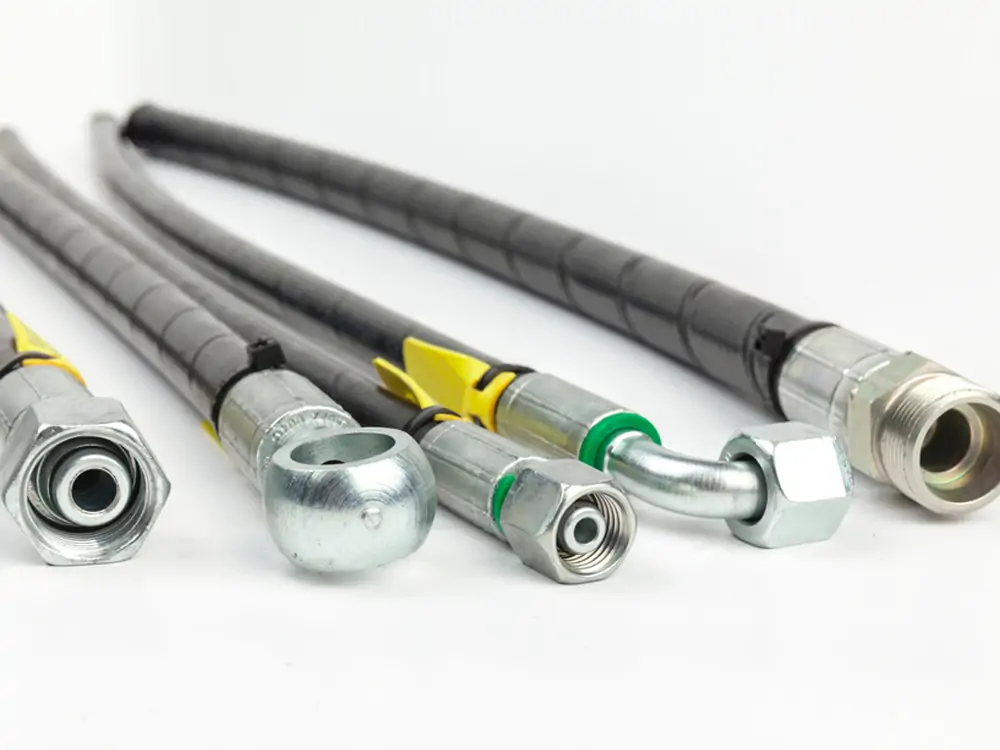For any tube to function under a hydraulic system, it requires specific connectors. Similarly, hydraulic hose fittings are needed for hydraulic hoses. Based on different factors, the types of hydraulic fittings may vary. It may be based on their shape, material, pressure variety, and international standards.
This article highlights the most popular types of hydraulic fittings. We will learn the fundamentals of hose fittings and their different styles. In addition, we will also learn how to choose or identify the right hydraulic hose fittings for your application. Let’s explore more.
What is Hydraulic Hose Fittings?
Hose fittings are essential components of all sorts of hydraulic systems. They usually connect hydraulic hoses to other hydraulic components. You can often see them in a hydraulic system’s pumps, valves, and other parts. Besides this function, hydraulic hose fittings also provide different abilities. They can allow changes in the direction of fluid flow within a hydraulic system. For example, elbows and tees are typical examples in this case.
Moreover, hose fittings also help control the hydraulic fluid pressure within a system. In addition, they may be used to adapt hoses to different thread types or sizes. It ensures compatibility between various components. Finally, hydraulic fittings often include seals, such as O-rings or gaskets. It prevents hydraulic fluid leakage and maintains overall system integrity.
Different Types of Hydraulic Fittings
You know, the hydraulic system has extensive applications in most industries worldwide. Starting from auto vehicles to large machinery, we can find the use of this remarkable technology. This is why we often use different types of hydraulic fittings. In the following few sections, we will discuss those types and their primary applications.
We mainly categorized these hose fittings into five groups based on different factors. They are metric standards, shapes, materials, pressure, and specialized or custom design.

Based on Metric Standards
Matric standards are essential for ensuring compatibility & interchangeability. Specifically, they provide that the manufactured parts have consistent dimensions, materials, and performance. However, based on this standard, we can divide hydraulic hose fittings into five categories.
- SAE stands for Society of Automotive Engineers. It is an American measurement system, but they do have metrics standards. SAE J516 & SAE J518 are examples of SAW standards for hydraulic hose fittings.
- ISO stands for International Organization for Standardization. ISO standards are widely used globally. It also includes metric specifications for hydraulic hose fittings. ISO 12151 & ISO 12151-2 are examples of standards for hydraulic hose fittings.
- DIN stands for Deutsches Institut für Normung. This standard is commonly used in Europe. They are also aligned with the metric system. DIN 2353 is an example of a standard for metric compression fittings. This standard is commonly used in hydraulic systems.
- BS stands for British standard. Historically, the BS standard is associated with the British Imperial system. But BS EN ISO 8434-1 is an example of a British standard for metric hose fittings used in hydraulic systems.
- EN stands for European Norm. These standards are widely used in Europe and often align with ISO and DIN standards. For example, EN ISO 12151-2 specifies requirements for fittings with 24-degree cone connectors.
- ASME hydraulic fittings adhere to the standards of the American Society of Mechanical Engineers. These standards also ensure uniformity and compatibility within hydraulic systems.
Based on Different Shapes
The shape of hydraulic hose fittings varies due to the different needs of hydraulic systems. Each designed shape meets specific needs for fluid flow, pressure control, and directional changes. These fittings ensure efficiency and operation safety. Let’s explore more of their different shapes and unique applications.
- Straight fittings provide a direct, linear connection between two sides. The application is often found between two hoses or between a hose and a hydraulic component. These hose fittings are essential for straightforward alignments in hydraulic systems.
- Elbow fittings are crucial in hydraulic systems. They are specially designed to change the direction of fluid flow at various angles. This configuration is vital for systems requiring fluid flow in multiple directions.
- Tee fittings allow a single hose to split in two directions. As a result, it provides a branching point in the hydraulic system. This configuration is crucial for systems requiring fluid flow in multiple directions.
- Cross fittings: Like tee fittings, cross fittings allow fluid division into various directions. Conversely, cross fittings offer a more complex configuration than tee fittings. The most common example can be a configuration with four openings.
- Flange fittings have a flat, disc-like structure with multiple holes. These hydraulic hose fittings use multiple bolts for the connection. They ensure robust and leak-resistant connections. This design is particularly suitable for high-pressure applications. In addition, we can often find them in connection with more significant hydraulic components.
- Tapered fittings usually have a pointed end. As a result, it provides a tight seal when connected. The shape of the fittings provides a more gradual & precise engagement. For example, we often find its application in washing water guns in car washing shops.
Based on Different Materials
The diverse materials used in hydraulic fittings depend on various operational requirements. This diversity also depends on different industry-specific demands with hydraulic systems. However, each material brings unique characteristics to the fittings. These characteristics may influence strength, corrosion resistance, weight, and cost.
- Steel hydraulic fittings are known for their strength & durability. They are widely used in heavy-duty applications. Steel fittings exhibit excellent resistance to high pressure. Besides, they are highly suitable for demanding environments.
- Stainless steel hydraulic fittings combine both strength and corrosion resistance. They are ideal for applications where exposure to moisture or corrosive substances is a concern. Popular applications can be found in chemical processing, oil, food, and marine applications.
- Plastic hydraulic fittings are especially suitable for applications where weight is critical. Plastics usually are lightweight and cost-effective solutions for different hydraulic applications. However, they do not provide the strength of metal. Popular applications can be found in low-pressure hydraulic systems.
- Aluminum hydraulic fittings are recognized for their lightweight & corrosion-resistance property. These hydraulic hose fittings are favored in applications where weight reduction is paramount. Popular applications can be found in the aerospace & automotive industries.
Other Factors (Pressure, Sealing and Adaptors)
We must also consider other factors in hydraulic systems to ensure reliability & safety. In this case, pressure, sealing mechanisms, and using adapters like ferrules are crucial factors. Therefore, they also need careful attention while selecting the right hydraulic hose fittings. However, based on these factors, we have categorized hydraulic fittings into the following types of hydraulic fittings.
- High-pressure hose fittings are designed to withstand certain pressures based on different applications. They are especially suitable for heavy-duty applications. Popular examples include construction and manufacturing. In most cases, we often see steel as the primary material of these hydraulic hose fittings.
- Low-pressure hose fittings are suitable for applications where a system requires a low-pressure. These fittings offer cost-effective solutions. In most cases, plastics and aluminum can be seen as the primary materials.
- Single-ring hydraulic fittings incorporate a single sealing point to ensure secure & leak-free connections. These hose fittings are practical where a simplified sealing mechanism is sufficient,
- Double-ring fittings provide two sealing points. They provide more enhanced sealing integrity than single-ring hydraulic fittings.
- Ferrules are adapters to reinforce hose ends and secure connections within the hydraulic system. They are typically made of the same materials as hydraulic fittings. They are designed to crimp onto hose ends to provide structural support. In addition, they enhance the longevity of the hose fittings.

How Do You Choose Suitable Types of Hydraulic Fittings?
Choosing the suitable types of hydraulic fittings requires checking different parameters. They are pressure, application requirements, and fluid compatibility. Usually, a high-pressure environment necessitates fittings designed for robustness. On the other hand, low-pressure applications may benefit from cost-effective alternatives.
You can also evaluate sealing requirements. In this case, you can consider single/double ring fittings. Besides, ferrules and other adapters are chosen based on reinforcement needs. Understanding these key aspects lets engineers design hydraulic fittings for maximum performance & durability.
Rentonehose’s Industrial Hose Products And Services
Rentonehose provides a diverse range of industrial hose products and services. They can meet diverse needs from various sectors. In their stock, you’ll find hoses of varying quality and function. Most significantly, they ensure efficiency and safety.
Moreover, their durable products are widely used in the construction, industrial, and oil and gas industries. Furthermore, their services include expert guidance, hose assembly, and custom solutions. They ensure their clients receive customized items that match burdensome industry requirements. Rentonehose’s quality makes it a trusted industrial hose supplier.
Summary
Let’s wrap everything up! Hydraulic hose fittings are crucial components in fluid power systems. They ensure a seamless operation of machinery across various industries. The choice of materials, such as steel, stainless, plastic, and aluminum, caters to specific needs. Pressure, sealing, and adapters are crucial in designing efficient & reliable hydraulic systems.
Understanding these elements can help you select and implement the right hydraulic fittings. Therefore, you can optimize the performance & longevity of your system in diverse applications. For more information, feel free to contact us.
